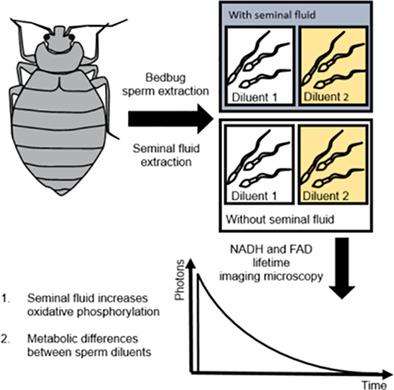当前位置:
X-MOL 学术
›
Microsc. Res. Tech.
›
论文详情
Our official English website, www.x-mol.net, welcomes your feedback! (Note: you will need to create a separate account there.)
Seminal fluid and sperm diluent affect sperm metabolism in an insect: Evidence from NAD(P)H and flavin adenine dinucleotide autofluorescence lifetime imaging
Microscopy Research and Technique ( IF 2.5 ) Pub Date : 2021-09-05 , DOI: 10.1002/jemt.23914 Christian Massino 1 , Cornelia Wetzker 1, 2 , Ondřej Balvin 3 , Tomáš Bartonicka 4 , Jana Kremenova 4 , Markéta Sasinkova 3 , Oliver Otti 5 , Klaus Reinhardt 1
Microscopy Research and Technique ( IF 2.5 ) Pub Date : 2021-09-05 , DOI: 10.1002/jemt.23914 Christian Massino 1 , Cornelia Wetzker 1, 2 , Ondřej Balvin 3 , Tomáš Bartonicka 4 , Jana Kremenova 4 , Markéta Sasinkova 3 , Oliver Otti 5 , Klaus Reinhardt 1
Affiliation

|
Sperm metabolism is fundamental to sperm motility and male fertility. Its measurement is still in its infancy, and recommendations do not exist as to whether or how to standardize laboratory procedures. Here, using the sperm of an insect, the common bedbug, Cimex lectularius, we demonstrate that standardization of sperm metabolism is required with respect to the artificial sperm storage medium and a natural medium, the seminal fluid. We used fluorescence lifetime imaging microscopy (FLIM) in combination with time-correlated single-photon counting (TCSPC) to quantify sperm metabolism based on the fluorescent properties of autofluorescent coenzymes, NAD(P)H and flavin adenine dinucleotide. Autofluorescence lifetimes (decay times) differ for the free and protein-bound state of the co-enzymes, and their relative contributions to the lifetime signal serve to characterize the metabolic state of cells. We found that artificial storage medium and seminal fluid separately, and additively, affected sperm metabolism. In a medium containing sugars and amino acids (Grace's Insect medium), sperm showed increased glycolysis compared with a commonly used storage medium, phosphate-buffered saline (PBS). Adding seminal fluid to the sperm additionally increased oxidative phosphorylation, likely reflecting increased energy production of sperm during activation. Our study provides a protocol to measure sperm metabolism independently from motility, stresses that protocol standardizations for sperm measurements should be implemented and, for the first time, demonstrates that seminal fluid alters sperm metabolism. Equivalent protocol standardizations should be imposed on metabolic investigations of human sperm samples.
中文翻译:

精液和精子稀释剂影响昆虫精子代谢:来自 NAD(P)H 和黄素腺嘌呤二核苷酸自发荧光寿命成像的证据
精子代谢是精子活力和男性生育能力的基础。它的测量仍处于起步阶段,对于是否或如何标准化实验室程序尚无建议。在这里,使用昆虫的精子,常见的臭虫Cimex lectularius,我们证明了人工精子储存介质和天然介质精液需要精子代谢标准化。我们使用荧光寿命成像显微镜 (FLIM) 结合时间相关单光子计数 (TCSPC) 根据自发荧光辅酶 NAD(P)H 和黄素腺嘌呤二核苷酸的荧光特性来量化精子代谢。自发荧光寿命(衰减时间)因辅酶的游离状态和蛋白质结合状态而异,它们对寿命信号的相对贡献用于表征细胞的代谢状态。我们发现人工储存介质和精液分别并相加地影响精子代谢。在含有糖和氨基酸的培养基(Grace's Insect 培养基)中,与常用的储存介质磷酸盐缓冲盐水 (PBS) 相比,精子的糖酵解增加。向精子中添加精液额外增加了氧化磷酸化,这可能反映了精子在激活过程中产生的能量增加。我们的研究提供了一个独立于运动性来测量精子代谢的协议,强调应该实施精子测量的协议标准化,并且首次证明精液会改变精子代谢。应对人类精子样本的代谢研究实施等效的协议标准化。可能反映了激活过程中精子能量产生的增加。我们的研究提供了一个独立于运动性来测量精子代谢的协议,强调应该实施精子测量的协议标准化,并且首次证明精液会改变精子代谢。应对人类精子样本的代谢研究实施等效的协议标准化。可能反映了激活过程中精子能量产生的增加。我们的研究提供了一个独立于运动性来测量精子代谢的协议,强调应该实施精子测量的协议标准化,并且首次证明精液会改变精子代谢。应对人类精子样本的代谢研究实施等效的协议标准化。
更新日期:2021-09-05
中文翻译:

精液和精子稀释剂影响昆虫精子代谢:来自 NAD(P)H 和黄素腺嘌呤二核苷酸自发荧光寿命成像的证据
精子代谢是精子活力和男性生育能力的基础。它的测量仍处于起步阶段,对于是否或如何标准化实验室程序尚无建议。在这里,使用昆虫的精子,常见的臭虫Cimex lectularius,我们证明了人工精子储存介质和天然介质精液需要精子代谢标准化。我们使用荧光寿命成像显微镜 (FLIM) 结合时间相关单光子计数 (TCSPC) 根据自发荧光辅酶 NAD(P)H 和黄素腺嘌呤二核苷酸的荧光特性来量化精子代谢。自发荧光寿命(衰减时间)因辅酶的游离状态和蛋白质结合状态而异,它们对寿命信号的相对贡献用于表征细胞的代谢状态。我们发现人工储存介质和精液分别并相加地影响精子代谢。在含有糖和氨基酸的培养基(Grace's Insect 培养基)中,与常用的储存介质磷酸盐缓冲盐水 (PBS) 相比,精子的糖酵解增加。向精子中添加精液额外增加了氧化磷酸化,这可能反映了精子在激活过程中产生的能量增加。我们的研究提供了一个独立于运动性来测量精子代谢的协议,强调应该实施精子测量的协议标准化,并且首次证明精液会改变精子代谢。应对人类精子样本的代谢研究实施等效的协议标准化。可能反映了激活过程中精子能量产生的增加。我们的研究提供了一个独立于运动性来测量精子代谢的协议,强调应该实施精子测量的协议标准化,并且首次证明精液会改变精子代谢。应对人类精子样本的代谢研究实施等效的协议标准化。可能反映了激活过程中精子能量产生的增加。我们的研究提供了一个独立于运动性来测量精子代谢的协议,强调应该实施精子测量的协议标准化,并且首次证明精液会改变精子代谢。应对人类精子样本的代谢研究实施等效的协议标准化。


























 京公网安备 11010802027423号
京公网安备 11010802027423号